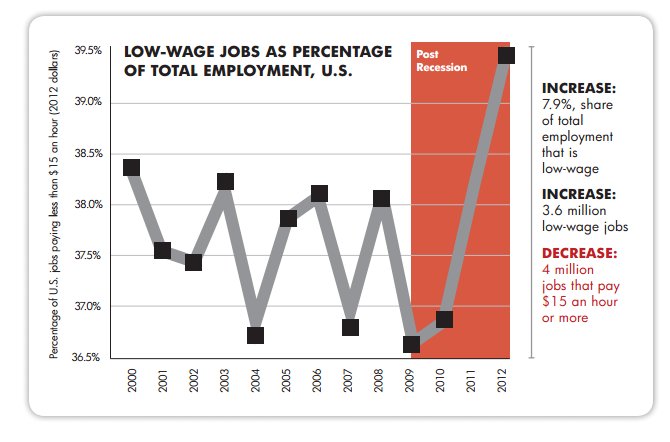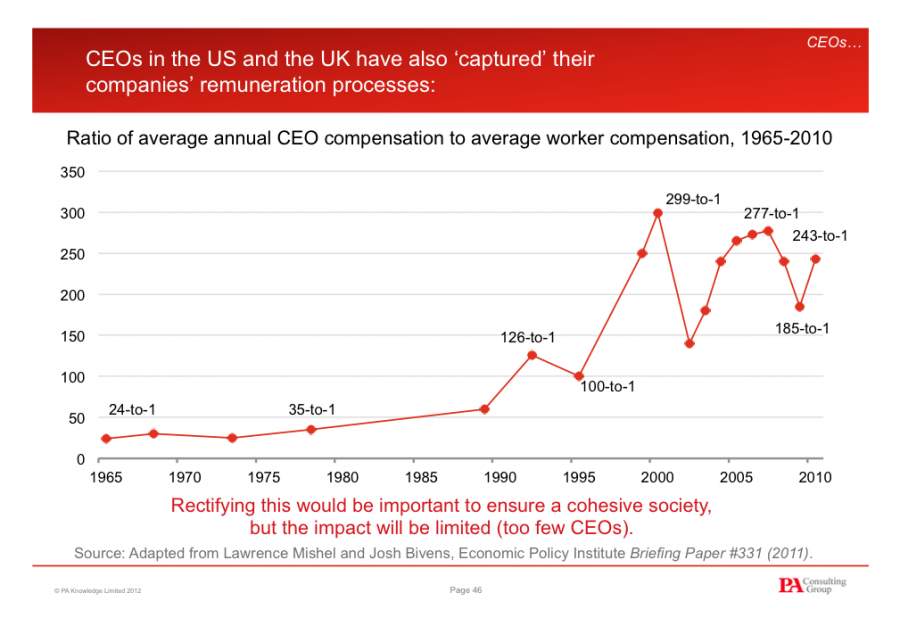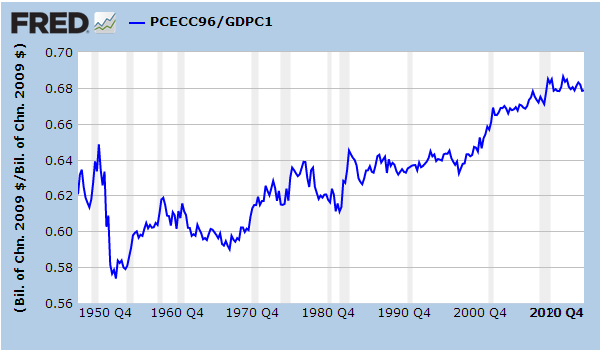A land of low-wage jobs: For every job that pays above the low-wage threshold of $15 an hour you have 7 job-seekers. 51.4 million low-wage jobs in U.S.
- 2 Comment
The Great Recession has only accelerated deeper structural changes to our economy when it comes to low-wage employment. While many good paying jobs were lost during the Great Recession many of the new jobs have come in the form of low-wage employment. Large organizations have used this slack in the market to reduce wages, cut benefits, and ultimately increase profits at the expense of the American worker. A Job Gap Study found that close to 40 percent of all U.S. employment pays $15 or less. The threshold changes in terms of inflationary pressures on housing, food, and other items but this is the largest share of our workforce that is now struggling to meet the daily costs of living. This trend is only increasing as more wealth is filtered into the hands of a very small part of our population. Banking profits hit another record at the same time we have a record number of families on food stamps. The U.S. is largely becoming a bifurcated economy where wealth and income inequality is only getting more dramatic. For every employment opportunity that opens where pay is $15 or more you have 7 job-seekers to this one position.
The growth of low-wage work
Some would argue that any work is better than no work. Yet the cost of living is getting more expensive thanks to our banking system and financial policies that largely favor a select group. The financial system should exist to prime the pump of real jobs (i.e., loans for small businesses, etc) versus existing merely to make a profit even on horrible speculative ventures. Chalk this up to bad politics and policy that essentially causes a system where austerity rains down on the public but corporate welfare is given out to those with deep purses. 51.4 million jobs across this country are considered to be low-wage jobs.
The number of jobs in the U.S. that do not meet a minimum level of cost of living has now surged into record territory. Nearly 40 percent of all jobs barely pay enough to get by, let alone allow families to join the middle class. Take a look at this chart showing the percent of low-wage jobs in the U.S.:
Source:Â Job Gap Study
Keep in mind that the recession officially ended in 2009. The reason the stock market has fully decoupled from the health of the American worker is varied:
-Many corporations are adding jobs overseas
-Many companies have cut wages, benefits, and are squeezing more out of current workers
-Financial and government policies favors the heavily connected, not the middle class
What you get is record salaries for CEOs while the middle class continues its slow decline. The above chart shows that 4 million jobs that pay more than $15 an hour have fully disappeared since the recession hit and have yet to comeback. On the other hand, we have increased low-wage jobs by 3.6 million.
I went ahead and pulled up the top employment sectors in the U.S. A generation ago some of the top fields included blue collar work that actually allowed families access to a middle class lifestyle. The top employment fields in the U.S. barely allow people to scrape by:
Source:Â BLS
“Every single one of the top employment sectors above pays less than $35,000 per year aside from that of registered nurses.â€
Then you wonder why consumers are massively in debt and are going into deeper debt to go to college to hopefully have a chance of getting out of the low-wage grind. The only solid paying field on the list above requires a college education. Just look at the ratio of CEO pay to the average worker:
Back in 1965 when the middle class was thriving, the ratio of CEO pay to the average worker was something like 24-to-1. This hit a recent peak during the tech bubble and also the current debt bubble of 2007. The recovery has been very beneficial at the top while for most workers, good paying jobs are hard to come by and inflation is slowly eroding the purchasing power of the dollar. In a consumer based economy, where roughly 70 percent of our economy is based on spending it is not beneficial when you squeeze your largest customer:
Consumption as share of GDP
A low-wage economy is not one in which most people will be thriving and certainly not one that will be driven by spending.
 If you enjoyed this post click here to subscribe to a complete feed and stay up to date with today’s challenging market!Â
If you enjoyed this post click here to subscribe to a complete feed and stay up to date with today’s challenging market!Â
       Â
If you enjoyed this post click here to subscribe to a complete feed and stay up to date with today’s challenging market!
2 Comments on this post
Trackbacks
-
Steven said:
The real minimum wage is the price of a single family home divided by equal to or less than 6000 man hours. Any rate less than that is kiddie pay or slave wages. Either pay rates have to rise or real estate prices need to be severely slashed and capped for the good of humanity. I don’t have a problem with private property. I just have a problem with people being priced out of the country they were born in and prevented from breeding because of extreme costs and low pay.
March 21st, 2014 at 6:29 am -
Walter Ruggieri said:
There is a huge disconnect between the stock market and main street. stocks are at record highs and main street has no budged in years. It used to be possible to have a nice life in America without a college degree, now it’s even getting harder to have a nice life with a college degree. Maybe a collapse of some sort would be a reset, but it would also be very painful.
March 27th, 2014 at 3:28 pm



